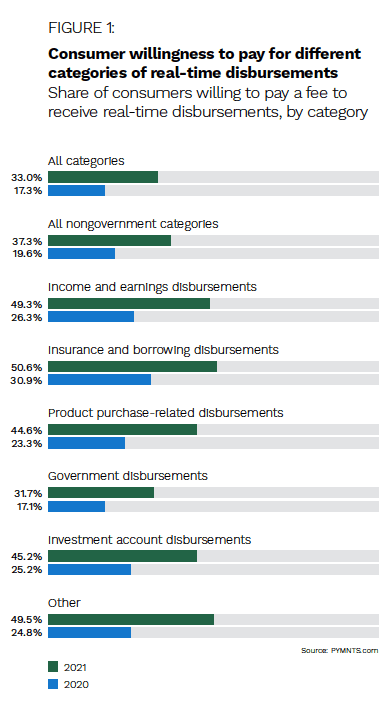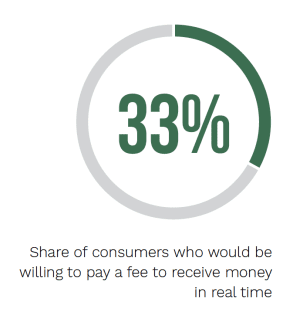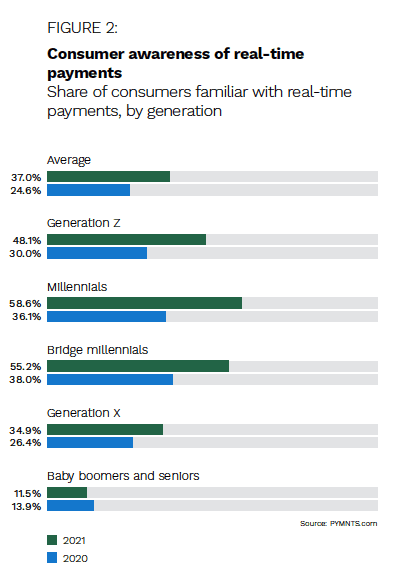How Consumers Are Driving Demand for Real-Time Payments

Consumers’ payment needs have undergone a sea change over the past two years, and access to real-time payments is becoming a requirement that many never knew they had.
Homeowners want their mortgage payments to clear the moment they press “send,” and workers enjoy not having to wait for their paychecks to become available in their bank accounts. Access to real-time payment options means consumers’ money is available for spending as soon as funds are sent to their accounts.
Real-time payments are one of the most important trends defining the consumer payments landscape today. Instant payments reached a global market value of $10.6 billion in 2020 and are expected to grow at a compound annual growth rate (CAGR) of 33% from 2021 to 2028. Real-time payments are also valuable to businesses, as they can significantly improve both cash flow and operational efficiencies. Consumers are a main driver of this payment option, however — in both making and receiving payments. This month, PYMNTS examines the consumer demand for real-time payments and reveals which demographics are driving this growth the most.
Consumer Demographics Most Interested in Real-Time Payments
Consumer interest in real-time payments continues to accelerate, with PYMNTS’ latest research showing that 20% of all U.S. consumers now cite receiving real-time payments most frequently for at least one type of disbursement, compared to only 14% one year ago. Most of those payments are paychecks or other income sources delivered via real-time payment rails.
Overall, the use of real-time disbursements has tripled since 2020. PYMNTS’ research found that real-time disbursements accounted for 17% of all disbursements made in 2021, up from 5.7% last year. By contrast, the shares of consumers who chose to receive disbursements via cash and check dropped 35% and nearly 50%, respectively, since 2020.
These shifts underpin consumers’ growing familiarity with real-time payments, as 15% more consu mers would be likely to choose real-time disbursements if they had a choice now than the share who indicated the same last year. Younger consumers are leading the trend, with bridge millennials and millennials being 24% and 26% likelier, respectively, to choose real-time payment options now than a year ago.
mers would be likely to choose real-time disbursements if they had a choice now than the share who indicated the same last year. Younger consumers are leading the trend, with bridge millennials and millennials being 24% and 26% likelier, respectively, to choose real-time payment options now than a year ago.
Cost does not necessarily alter this preference. In fact, 33% of consumers would be willing to pay a fee to receive money in real time. This represents more than double the share who indicated the same in 2020. About half of insurance, income and earnings disbursement recipients would be willing to pay a fee to receive those payments instantly, making them the most likely group to do so, but only about 32% of government disbursement recipients would be willing to pay such a fee.
Freedom of choice appears to be the major factor driving consumers toward the use of real-time payments, and individuals appear to have more choices than a year ago. Consumers had the ability to choose real-time payments for 71% of disbursements they received in 2021, but only 57% had the same opportunity a year ago. Most of their choices were for income and earnings disbursements. Seventy-five percent of these disbursements in 2021 came with a choice of payment method, yet only 61% of purchase-related disbursements came with the same choice.
 These findings are important for businesses adopting the technology, as two-thirds of consumers said they would be more likely to continue doing business with firms that provide a free real-time payment option — an increase from the 61% who said the same in 2020. Consumers want their money quickly, and only about one-third said they would continue relationships with payors if checks were the only payment method available.
These findings are important for businesses adopting the technology, as two-thirds of consumers said they would be more likely to continue doing business with firms that provide a free real-time payment option — an increase from the 61% who said the same in 2020. Consumers want their money quickly, and only about one-third said they would continue relationships with payors if checks were the only payment method available.
PYMNTS’ research also found that consumers consider access to real-time payments to be a key factor in their choice of a financial institution (FI), with nearly one-quarter willing to switch FIs to gain access to real-time payments. This is especially true of younger consumers and those who need readily accessible funds. PYMNTS’ research found that 38% of Generation Z consumers, 47% of consumers who review their accounts after every transaction and 40% of consumers who live paycheck to paycheck and struggle to pay their bills are “very” or “extremely” likely to switch FIs to acquire real-time payment capabilities.

Consumers — especially those who are younger or financially challenged — clearly have a high level of interest in the ability to use real-time payments, and a significant share are willing to pay or switch FIs for this option. The demand could be even higher, however, if more consumers were familiar with the method. PYMNTS’ research shows that 37% of consumers are now familiar with real-time payments — up from 25% a year ago. This is a significant rise, but there is much room for improvement, given the figures among younger generations. Fifty-nine percent of millennials, 55% of bridge millennials and 48% of Gen Z consumers said they are familiar with real-time payments.
